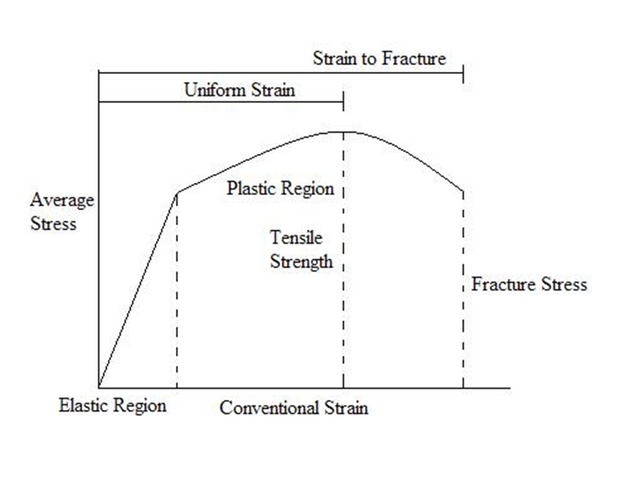Physics - Classical Mechanics - Tensile Stress and Strain
[Image 1]
Introduction
Hey it's a me again @drifter1! Today we continue with Physics and more specifically the branch "Classical Mechanics" to continue with the chapter of Equilibrium and Elasticity. In this article we will get into Tensile Stress and Strain. So, without further ado, let's dive straight into it!
Tensile Stress
Tensile stress is defined as the resistance an object has to forces tending to break it. It is equal to the force per unit area that a material can endure without tearing apart. The maximum stress that the material can stand is called the ultimate tensile stress or breaking stress.Stress is defined by the following formula:

- σ = tensile stress measured in N/m2 or pascals (Pa)
- F = force in newtons (N)
- A = cross-sectional area in m2
- Elastic modulus
- Ultimate tensile stress (UTS)
- Modulus of resilience
- Fracture stress
Tensile Strain
The ratio of extension to original length is called strain and has no units. Mathematically, we can write it as following:
- ε = tensile strain with no units
- ΔL = extension measured in metres (m)
- L = original length measured in metres (m)
Young's Modulus
Young's modulus of elasticity is defined as "The mechanical property of a material to withstand the compression or elongation with respect to its length". It is denoted as E or Y. Using Hooke's Law of elasticity, Young's modulus is defined as:
- σ = tensile stress
- ε = tensile strain
- F = tensile force
- A = cross-sectional area
- L0 = original length
- Ln = new length
Poisson's Ratio
Stretching a material in one diretion it tends to get thinner, whilst compressing it tends to make it thicker in the lateral direction. Poisson's ratio is expressed as:
- μ = Poisson's ratio
- εt = transverse strain
- εl = longitudinal or axial strain

- εt = longitudinal or axial strain
- ΔL = change in length
- L = initial length

- εl = transverse, lateral or radial strain
- Δr = change in radius
- r = initial radius
RESOURCES:
References
- https://www.corrosionpedia.com/definition/1073/tensile-stress
- http://physicsnet.co.uk/a-level-physics-as-a2/materials/stress-strain/
- https://byjus.com/physics/tensile-stress/
- https://byjus.com/physics/youngs-modulus-elastic-modulus/
- https://www.britannica.com/science/Youngs-modulus
- https://www.engineeringtoolbox.com/poissons-ratio-d_1224.html
Images
Mathematical equations used in this article, where made using quicklatex.
Previous articles of the series
Rectlinear motion
- Velocity and acceleration in a rectlinear motion -> velocity, acceleration and averages of those
- Rectlinear motion with constant acceleration and free falling -> const acceleration motion and free fall
- Rectlinear motion with variable acceleration and velocity relativity -> integrations to calculate pos and velocity, relative velocity
- Rectlinear motion exercises -> examples and tasks in rectlinear motion
Plane motion
- Position, velocity and acceleration vectors in a plane motion -> position, velocity and acceleration in plane motion
- Projectile motion as a plane motion -> missile/bullet motion as a plane motion
- Smooth Circular motion -> smooth circular motion theory
- Plane motion exercises -> examples and tasks in plane motions
Newton's laws and Applications
- Force and Newton's first law -> force, 1st law
- Mass and Newton's second law -> mass, 2nd law
- Newton's 3rd law and mass vs weight -> mass vs weight, 3rd law, friction
- Applying Newton's Laws -> free-body diagram, point equilibrium and 2nd law applications
- Contact forces and friction -> contact force, friction
- Dynamics of Circular motion -> circular motion dynamics, applications
- Object equilibrium and 2nd law application examples -> examples of object equilibrium and 2nd law applications
- Contact force and friction examples -> exercises in force and friction
- Circular dynamic and vertical circle motion examples -> exercises in circular dynamics
- Advanced Newton law examples -> advanced (more difficult) exercises
Work and Energy
- Work and Kinetic Energy -> Definition of Work, Work by a constant and variable Force, Work and Kinetic Energy, Power, Exercises
- Conservative and Non-Conservative Forces -> Conservation of Energy, Conservative and Non-Conservative Forces and Fields, Calculations and Exercises
- Potential and Mechanical Energy -> Gravitational and Elastic Potential Energy, Conservation of Mechanical Energy, Problem Solving Strategy & Tips
- Force and Potential Energy -> Force as Energy Derivative (1-dim) and Gradient (3-dim)
- Potential Energy Diagrams -> Energy Diagram Interpretation, Steps and Example
- Internal Energy and Work -> Internal Energy, Internal Work
Momentum and Impulse
- Conservation of Momentum -> Momentum, Conservation of Momentum
- Elastic and Inelastic Collisions -> Collision, Elastic Collision, Inelastic Collision
- Collision Examples -> Various Elastic and Inelastic Collision Examples
- Impulse -> Impulse with Example
- Motion of the Center of Mass -> Center of Mass, Motion analysis with examples
- Explaining the Physics behind Rocket Propulsion -> Required Background, Rocket Propulsion Analysis
Angular Motion
- Angular motion basics -> Angular position, velocity and acceleration
- Rotation with constant angular acceleration -> Constant angular acceleration, Example
- Rotational Kinetic Energy & Moment of Inertia -> Rotational kinetic energy, Moment of Inertia
- Parallel Axis Theorem -> Parallel axis theorem with example
- Torque and Angular Acceleration -> Torque, Relation to Angular Acceleration, Example
- Rotation about a moving axis (Rolling motion) -> Fixed and moving axis rotation
- Work and Power in Angular Motion -> Work, Work-Energy Theorem, Power
- Angular Momentum -> Angular Momentum and its conservation
- Explaining the Physics behind Mechanical Gyroscopes -> What they are, History, How they work (Precession, Mathematical Analysis) Difference to Accelerometers
- Exercises around Angular motion -> Angular motion examples
Equilibrium and Elasticity
- Rigid Body Equilibrium -> Equilibrium Conditions of Rigid Bodies, Center of Gravity, Solving Equilibrium Problems
- Force Couple System -> Force Couple System, Example
Final words | Next up
And this is actually it for today's post!Next time we will continue with Volumetric Tension and Strain...
See ya!
Keep on drifting!




Hi @drifter1!
Your post was upvoted by @steem-ua, new Steem dApp, using UserAuthority for algorithmic post curation!
Your UA account score is currently 3.527 which ranks you at #6775 across all Steem accounts.
Your rank has not changed in the last three days.
In our last Algorithmic Curation Round, consisting of 106 contributions, your post is ranked at #30.
Evaluation of your UA score:
Feel free to join our @steem-ua Discord server
Hello,
Your post has been manually curated by a @stem.curate curator.
We are dedicated to supporting great content, like yours on the STEMGeeks tribe.
If you like what we are doing, please show your support as well by following our Steem Auto curation trail.
Please join us on discord.
As a follower of @followforupvotes this post has been randomly selected and upvoted! Enjoy your upvote and have a great day!
This post has been voted on by the SteemSTEM curation team and voting trail. It is elligible for support from @curie and @minnowbooster.
If you appreciate the work we are doing, then consider supporting our witness @stem.witness. Additional witness support to the curie witness would be appreciated as well.
For additional information please join us on the SteemSTEM discord and to get to know the rest of the community!
Please consider using the steemstem.io app and/or including @steemstem in the list of beneficiaries of this post. This could yield a stronger support from SteemSTEM.